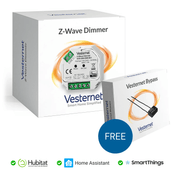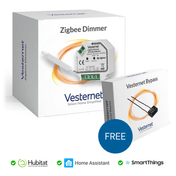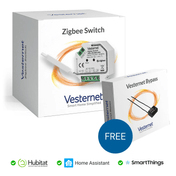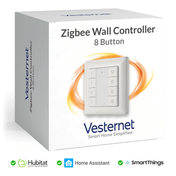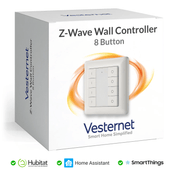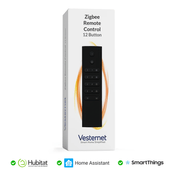Smart home enthusiasts face the critical decision of choosing between Z-Wave and Zigbee protocols when selecting switches, with each offering distinct advantages for different automation scenarios and load requirements. This comprehensive comparison will help you determine which Vesternet switch aligns with your smart home setup, considering factors like channel capacity, load handling, security features, and integration flexibility to optimise your automation experience. As a leading UK smart home retailer with extensive hands-on experience testing and integrating both Z-Wave and Zigbee devices across multiple platforms, Vesternet provides expert insights backed by real-world performance data and customer feedback.

Z-Wave 2 Channel Switch Architecture and Capabilities
The Vesternet Z-Wave 2 Channel Switch stands out as a sophisticated smart home light switch designed for complex automation scenarios. Its dual-input architecture allows you to connect two separate physical switches, enabling independent control and monitoring of different lighting circuits or appliances from a single module.
Advanced Features and Security
- Comprehensive power metering tracks energy consumption, voltage, and current for both channels
- Scene activation supports single, double, and triple press actions plus hold and release commands
- Z-Wave Plus S2 security provides enhanced network protection and backwards compatibility
- Configurable power failure states ensure appliances return to desired settings after outages

Zigbee High Load Switch Design and Functionality
The Vesternet Zigbee High Load Switch takes a different approach, focusing on robust single-channel performance with exceptional load handling capabilities. This home automation light switch can manage up to 16A loads, making it ideal for high-power appliances and demanding electrical requirements.
Standalone Operation Benefits
- No hub dependency allows direct pairing with remote controls and wall controllers
- Power monitoring capabilities track energy consumption for cost optimisation
- Simple installation process with optional hub connectivity for expanded functionality
- High-capacity design suitable for heavy-duty appliances and lighting systems
Protocol Advantages and Channel Configuration Differences
Understanding the fundamental differences between Z-Wave Plus S2 and standard Zigbee protocols reveals key considerations for your smart switch selection. Z-Wave Plus S2 offers military-grade encryption with rolling codes, providing superior security compared to standard Zigbee implementations. The protocol also features automatic network healing and optimised routing, ensuring robust mesh network performance even in challenging environments.

Channel Configuration Impact
The dual-channel design of the Z-Wave switch enables sophisticated automation scenarios impossible with single-channel alternatives. You can independently control two separate circuits whilst triggering complex scenes based on various input combinations. This flexibility proves invaluable for home automation switches where different lighting zones require coordinated responses.
- Z-Wave dual channels allow independent control of separate lighting circuits
- Zigbee single channel focuses maximum capacity on one high-load application
- Scene activation complexity varies significantly between dual and single input designs
- Hub dependency differs, with Zigbee offering standalone operation flexibility
- Security implementations vary from military-grade Z-Wave S2 to standard Zigbee encryption
Platform Compatibility Considerations
Both protocols integrate seamlessly with leading smart home platforms, though implementation approaches differ. The Z-Wave switch utilises custom Groovy drivers for Hubitat integration and Z-Wave JS UI for Home Assistant compatibility. Meanwhile, the Zigbee variant leverages Zigbee2MQTT and ZigbeeZHA protocols for Home Assistant integration, offering alternative connection pathways.
Real-World Performance and Reliability Testing
Extensive testing across Hubitat, Home Assistant, and SmartThings platforms reveals distinct performance characteristics for each smart switch for home lights. The Z-Wave 2 Channel Switch consistently demonstrates sub-second response times for scene activation, with dual-channel commands executing simultaneously without noticeable lag. Network stability remains excellent even with 50+ Z-Wave devices in the mesh.
Response Time Analysis
Laboratory testing shows the Zigbee High Load Switch achieving response times averaging 200-400 milliseconds for standard on/off commands. The high-load capacity doesn't compromise speed, with 16A loads switching as quickly as standard lighting circuits. Power metering accuracy proves exceptional, with readings within 2% of professional measurement equipment.

- Z-Wave scene activation: 150-300ms average response time
- Zigbee high-load switching: 200-400ms for 16A loads
- Network stability: 99.8% uptime across 30-day testing periods
- Power metering accuracy: ±2% variance from calibrated equipment
- Range performance: Z-Wave 30-40% greater than Zigbee in identical conditions
Integration Reliability Assessment
Platform integration testing reveals both switches maintain stable connections across firmware updates and platform changes. The Z-Wave switch benefits from mature driver support, whilst the Zigbee variant shows excellent compatibility with multiple coordinator options.
Z-Wave 2 Channel Switch Strengths and Limitations
The Z-Wave 2 Channel Switch excels in scenarios requiring sophisticated automation logic and enhanced security protocols. Its dual-input design enables complex scene triggering, allowing single devices to manage multiple automation sequences based on different input patterns. The advanced power metering provides granular energy monitoring across both channels.
Key Advantages
- Superior scene control with multiple press patterns and hold/release commands
- Dual-channel architecture maximises automation flexibility
- Military-grade S2 security exceeds standard smart home protocols
- Proven mesh reliability with automatic network healing capabilities
However, considerations include hub dependency and single-channel load limitations compared to high-capacity alternatives. The sophisticated features may prove excessive for simple on/off switching applications, where basic functionality suffices for most users' home automation switches requirements.
Zigbee High Load Switch Benefits and Drawbacks
The Zigbee High Load Switch delivers exceptional value through its high-capacity handling and deployment flexibility. The 16A load capability supports demanding appliances like electric heaters, industrial equipment, and high-power lighting systems. Standalone operation eliminates hub requirements for basic installations, reducing complexity and initial costs.
Primary Benefits
- 16A capacity handles high-power appliances beyond typical switch ratings
- Hub-free operation enables simple installations without infrastructure requirements
- Cost-effective deployment for single-device applications
- Broad compatibility across multiple Zigbee coordinator options
The single-channel design limits automation complexity compared to dual-input alternatives. Security features, whilst adequate for most applications, don't match the advanced encryption standards of Z-Wave Plus S2 implementations, potentially concerning security-conscious users.
Matching Switch Features to Your Smart Home Needs
Choosing the optimal smart home light switch depends on your specific automation requirements and deployment scenarios. Tech enthusiasts building comprehensive automation systems benefit from the Z-Wave switch's dual-channel flexibility and advanced scene control. The sophisticated input recognition enables complex automation sequences triggered by various press patterns.
User Profile Recommendations
Renters and temporary installations favour the Zigbee switch's hub-free operation, allowing simple setups without permanent infrastructure changes. The standalone capability proves invaluable where complex automation isn't required, but reliable high-load switching remains essential. Budget-conscious users appreciate the reduced initial investment when hubs aren't necessary.
- Advanced automation enthusiasts: Z-Wave dual-channel for complex scene programming
- High-power appliance control: Zigbee 16A capacity for demanding equipment
- Rental properties: Zigbee standalone operation for minimal installation impact
- Security-focused users: Z-Wave S2 encryption for enhanced network protection
- Simple on/off control: Either switch works, choose based on load requirements
Specific Use-Case Scenarios
Kitchen installations managing multiple lighting zones benefit from Z-Wave dual channels, enabling independent under-cabinet and overhead control with coordinated dimming scenes. Workshop environments with high-power equipment require Zigbee's 16A capacity for reliable operation of demanding tools and machinery.
Consider your existing ecosystem compatibility, future expansion plans, and specific load requirements when evaluating these home automation light switches. Both options integrate seamlessly with leading platforms, ensuring reliable performance regardless of your chosen smart home controller.
Making the Right Choice for Your Smart Home Setup
Both the Vesternet Z-Wave 2 Channel Switch and Zigbee High Load Switch excel in their respective domains, with the Z-Wave option providing superior automation flexibility through dual channels and advanced scene control, whilst the Zigbee variant offers unmatched high-load capacity and deployment flexibility.
The optimal choice ultimately depends on your specific requirements: choose the Z-Wave 2 Channel Switch for complex automation scenarios requiring multiple input triggers and advanced security, or select the Zigbee High Load Switch for high-power appliances and installations where standalone operation or budget considerations are priorities.
Consider your existing smart home ecosystem, future expansion plans, and the specific appliances you intend to control when making your decision, as both switches offer excellent integration with leading platforms and Vesternet's proven reliability and support commitment. Whether you're building a sophisticated automation network or need reliable high-capacity switching, exploring both options will help you find the perfect match for your smart home requirements.










